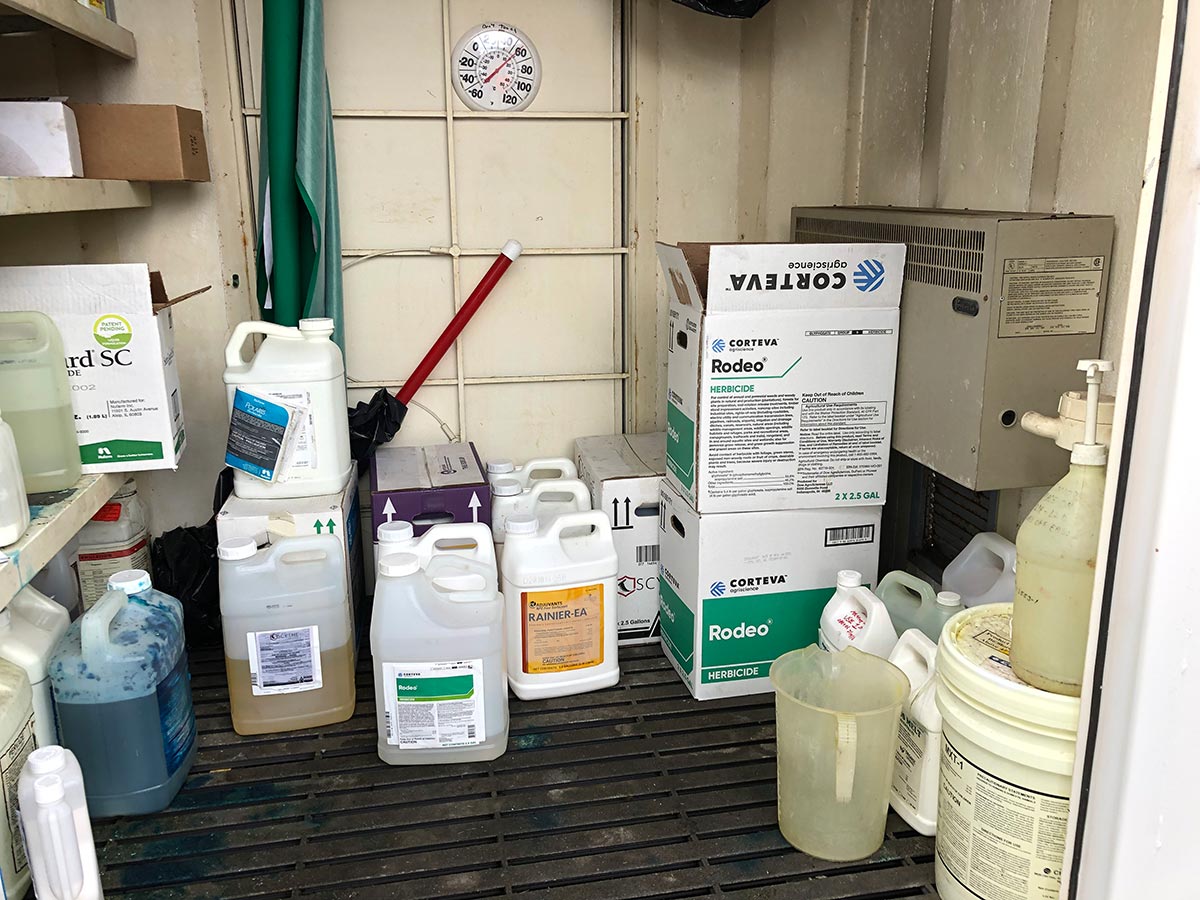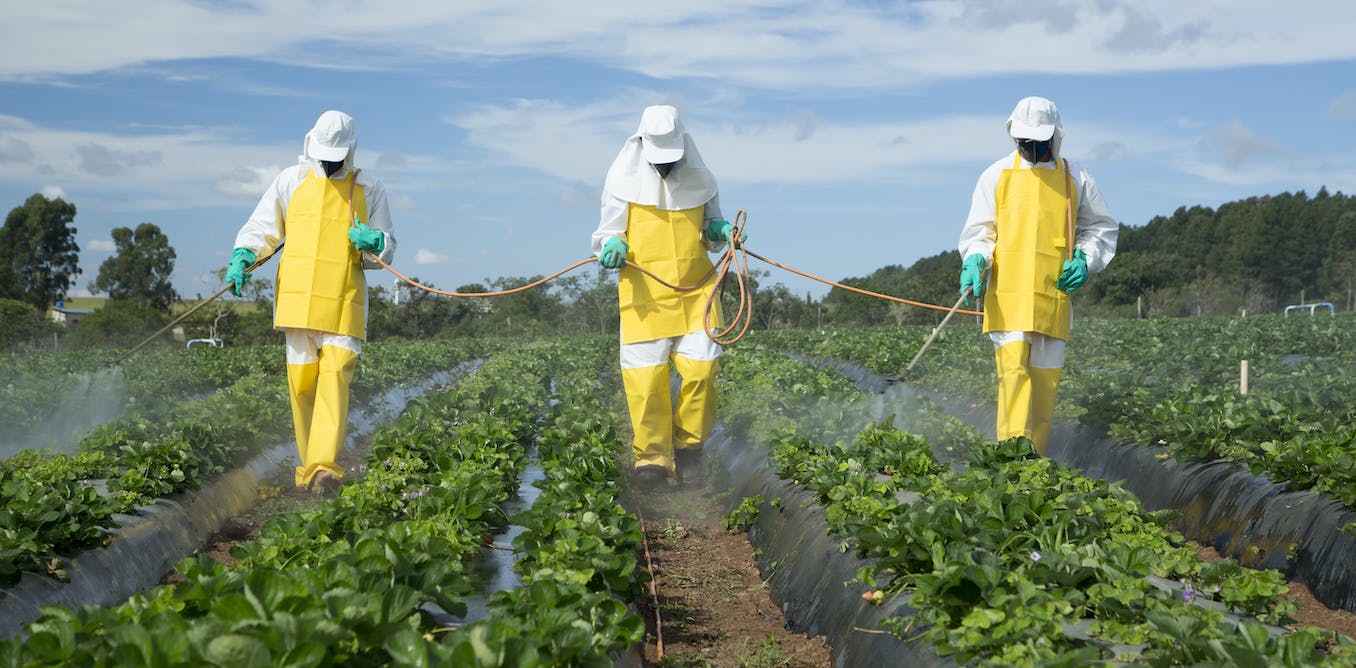Home>Gardening News and Trends>Latest News>Where Should Chemicals And Pesticides Be Stored


Latest News
Where Should Chemicals And Pesticides Be Stored
Published: November 25, 2023
Discover the latest news on chemical and pesticide storage. Learn where these hazardous substances should be stored to ensure safety and compliance.
(Many of the links in this article redirect to a specific reviewed product. Your purchase of these products through affiliate links helps to generate commission for Chicagolandgardening.com, at no extra cost. Learn more)
Table of Contents
- Introduction
- Importance of Proper Storage for Chemicals and Pesticides
- Factors to Consider When Selecting a Storage Location
- Outdoor Storage Options
- Indoor Storage Options
- Common Mistakes to Avoid in Chemical and Pesticide Storage
- Safety Measures for Handling and Storing Chemicals and Pesticides
- Legal Regulations and Guidelines for Chemical and Pesticide Storage
- Proper Disposal Methods for Expired or Unused Chemicals and Pesticides
- Conclusion
Introduction
Welcome to our comprehensive guide on the storage of chemicals and pesticides. As chemical substances and pesticides play a crucial role in various industries, it is essential to handle and store them safely to ensure the well-being of individuals and the environment. Improper storage can lead to accidents, environmental contamination, and potential health hazards. Hence, understanding the importance of proper storage practices and following legal regulations is of utmost importance to maintain safety.
In this article, we will explore the factors to consider when selecting a storage location for chemicals and pesticides. We will also discuss both outdoor and indoor storage options, common mistakes to avoid in storage, safety measures for handling and storing these substances, legal regulations and guidelines to adhere to, and proper disposal methods for expired or unused chemicals and pesticides. By the end of this guide, you will have a clear understanding of how to store chemicals and pesticides effectively and responsibly.
Whether you are a homeowner with a small garden or an industrial facility handling large quantities of chemicals, this article will provide you with valuable insights to securely store these substances.
So, let’s dive in and explore the world of chemical and pesticide storage, prioritizing safety and environmental consciousness.
Importance of Proper Storage for Chemicals and Pesticides
The proper storage of chemicals and pesticides is of paramount importance for the safety of individuals, the environment, and property. Failure to store these substances appropriately can result in various hazards, including accidents, fires, releases of harmful toxins, and contamination of soil and water sources. Therefore, understanding the importance of proper storage practices is crucial in mitigating these risks.
One of the primary reasons for ensuring proper storage is to minimize the potential for accidents and injuries. Chemicals and pesticides can be highly toxic and pose a significant risk if mishandled or stored improperly. By storing these substances in designated areas with appropriate safety measures, the likelihood of accidental exposure or ingestion is significantly reduced.
Proper storage also helps to protect the environment. When chemicals and pesticides are not stored securely, they can leak or spill, leading to contamination of soil and water sources. The negative impact on ecosystems and wildlife can be severe and long-lasting. By storing these substances in suitable containers and following strict storage guidelines, the risk of environmental pollution can be minimized.
In addition to safety and environmental concerns, proper storage also helps to maintain the quality and effectiveness of chemicals and pesticides. Many of these substances are sensitive to factors such as temperature, humidity, and exposure to light. Inadequate storage conditions can degrade the potency of these substances, rendering them ineffective or even hazardous to use. By storing chemicals and pesticides in controlled environments, their efficacy and shelf life can be preserved.
Moreover, proper storage practices play a crucial role in meeting legal regulations and guidelines. Different regions and industries have specific requirements for the storage of chemicals and pesticides. By complying with these regulations, individuals and organizations can avoid penalties, legal consequences, and reputational damage.
Lastly, implementing proper storage practices for chemicals and pesticides also promotes overall organizational safety and risk management. By ensuring that these substances are stored safely and securely, companies can create a culture of safety and minimize the potential for accidents or incidents within their facilities.
In summary, the importance of proper storage for chemicals and pesticides cannot be overstated. It ensures the safety of individuals, protects the environment, maintains the quality of substances, complies with legal regulations, and promotes overall organizational safety. By prioritizing proper storage practices, we can mitigate the risks associated with handling these substances and create a safer and more sustainable future.
Factors to Consider When Selecting a Storage Location
Choosing the right storage location for chemicals and pesticides is crucial to ensure their safety and prevent any potential risks. Several factors should be taken into consideration when deciding on a storage area:
- Accessibility: The storage location should be easily accessible to authorized personnel. It should be conveniently located near the work area where these substances are used, allowing for efficient retrieval and handling.
- Security: Security measures are vital to prevent unauthorized access and potential theft or tampering with chemical or pesticide containers. Lockable storage cabinets, security cameras, and restricted access are some of the security measures that can be implemented.
- Compatibility: Consider the compatibility of chemicals and pesticides when storing them together. Certain substances may react with each other, leading to dangerous reactions or even explosions. It is important to consult Material Safety Data Sheets (MSDS) and separate incompatible substances accordingly.
- Climate control: Some chemicals and pesticides require specific temperature and humidity conditions to maintain their stability and effectiveness. The storage location should provide climate control capabilities, such as temperature-controlled rooms or air conditioning, to meet the requirements of these substances.
- Ventilation: Adequate ventilation is essential in the storage area to prevent the buildup of toxic fumes or gases. A well-ventilated space helps maintain air quality and reduces the risk of inhalation hazards.
- Fire safety: The storage location should be free from potential sources of ignition and equipped with proper fire safety measures. Fire extinguishers, fire-resistant cabinets, and adequate spacing between chemical containers are some precautions to minimize fire hazards.
- Storage containers: Choose appropriate storage containers that are compatible with the chemicals and pesticides being stored. Containers should be made of suitable materials, such as high-density polyethylene (HDPE) or stainless steel, and come with tightly sealed lids to prevent leaks and spills.
- Labeling: Clearly label all containers with the name of the substance, hazard warnings, and date of storage. Proper labeling helps identify and locate specific chemicals and ensures that they are handled and used safely.
- Emergency preparedness: Establish emergency response protocols and have safety equipment readily available in the storage area, including spill kits, safety showers, and eyewash stations. Conduct regular training sessions for employees to ensure they are aware of emergency procedures.
By carefully considering these factors, individuals and organizations can select an appropriate storage location that meets safety requirements, ensures the integrity of chemicals and pesticides, and minimizes potential risks.
Outdoor Storage Options
When indoor storage space is limited or certain chemicals and pesticides require specific conditions, outdoor storage becomes a viable option. However, it is essential to take precautions to ensure the safety and integrity of these substances. Here are some outdoor storage options to consider:
- Chemical sheds: Chemical sheds are specifically designed storage units for outdoor use. They are constructed with durable materials that are resistant to weather conditions, such as corrosion-resistant steel or reinforced plastic. Chemical sheds provide protection against direct sunlight, rain, and other environmental factors.
- Secondary containment systems: When storing chemicals and pesticides that may spill or leak, it is crucial to implement secondary containment systems. These systems consist of impermeable barriers, such as trays or bunds, that can contain any potential leaks and prevent them from reaching the surrounding environment.
- Storage cabinets: Outdoor storage cabinets are available in various sizes and materials, including weather-resistant plastic or stainless steel. These cabinets provide additional protection against the elements and can be equipped with lockable doors for security.
- Hazardous material storage buildings: For large-scale storage needs, hazardous material storage buildings are a suitable option. These structures are designed with ventilation systems, fire suppression measures, and proper insulation to ensure the safe storage of chemicals and pesticides.
- Pallets and racks: Storing chemicals and pesticides on pallets or racks can help organize the outdoor storage area and prevent direct contact with the ground. The pallets should be made of non-reactive materials that can withstand outdoor conditions, such as plastic or galvanized steel.
- Signage and fencing: Clearly mark the outdoor storage area with signs indicating the presence of hazardous materials. Use barriers or fences to restrict access to authorized personnel only, reducing the risk of unauthorized handling or potential accidents.
- Protection from extreme temperatures: Extreme temperatures can impact the stability and effectiveness of chemicals and pesticides. Consider implementing measures to protect the substances from excessive heat or cold, such as shading structures, insulation, or temperature-controlled containers.
- Regular inspections: Regularly inspect outdoor storage areas to ensure that containers and storage units are in good condition, free from damage or corrosion. Inspections should also include checks for any signs of leakage, proper labeling, and compliance with safety regulations.
It is important to note that not all chemicals and pesticides are suitable for outdoor storage. Some substances may have specific requirements that can only be met through indoor storage. Therefore, always refer to the manufacturer’s guidelines and consult with professionals before determining the appropriate storage option for specific substances.
By utilizing these outdoor storage options and implementing proper safety measures, individuals and organizations can store chemicals and pesticides securely, even in outdoor environments.
Indoor Storage Options
Indoor storage of chemicals and pesticides offers several advantages, including better protection from environmental factors, improved security, and greater control over storage conditions. When selecting indoor storage options, consider the following:
- Chemical storage cabinets: Chemical storage cabinets are one of the most common and effective options for indoor storage. These cabinets are made of materials resistant to corrosion, such as steel or polyethylene, and come in various sizes to accommodate different volumes of substances. They provide a secure and organized storage solution, with lockable doors to prevent unauthorized access.
- Secure rooms or designated areas: For larger quantities of chemicals and pesticides, dedicated rooms or areas can be allocated for storage. These spaces should be well-ventilated, properly ventilated, and secure. Lockable doors and restricted access ensure that only authorized personnel can enter the storage area.
- Shelving and racking systems: Utilize shelves and racks to maximize storage space and facilitate organization. Ensure that shelves are made of non-reactive materials and capable of supporting the weight of the stored containers. Separating substances based on compatibility is crucial to prevent any potential reactions or spills.
- Safety cabinets: In addition to chemical storage cabinets, safety cabinets are designed specifically for the storage of flammable or combustible substances. These cabinets have additional fire-resistant properties, such as double-wall construction or ventilation features, to reduce the risk of fire hazards.
- Temperature-controlled rooms: Some chemicals and pesticides require specific temperature conditions to maintain their stability and effectiveness. Temperature-controlled rooms or refrigerators with adjustable settings can provide the necessary environment for these substances. Regular monitoring of temperature and humidity levels is essential to ensure consistency.
- Proper lighting: Adequate lighting in the storage area is necessary for easy identification of containers and label reading. Ensure that the lighting fixtures are suitable for use in indoor environments and comply with safety regulations.
- Spill containment measures: Even with indoor storage, the risk of spills or leaks still exists. Implement spill containment measures, such as spill trays or absorbent material, to quickly and effectively contain any potential spills and prevent them from spreading.
- Regular inspections and maintenance: Conduct regular inspections to check for any signs of damage or deterioration in storage cabinets, shelves, and containers. Replace damaged or corroded equipment to maintain a safe and organized storage environment.
It is crucial to keep a detailed inventory of all chemicals and pesticides stored indoors, including their quantities, locations, and expiration dates. Regularly review and update the inventory to ensure accurate tracking and identification of materials.
By implementing appropriate indoor storage options and adhering to safety measures, individuals and organizations can effectively store chemicals and pesticides, minimize hazards, and maintain control over storage conditions.
Common Mistakes to Avoid in Chemical and Pesticide Storage
Proper storage practices are essential for the safe handling and storage of chemicals and pesticides. However, there are common mistakes that individuals and organizations often make, which can compromise safety and increase the risk of accidents or contamination. To maintain a secure storage environment, it is important to avoid the following common mistakes:
- Inadequate labeling: Failing to label chemical and pesticide containers correctly is a significant mistake. Clear and accurate labeling is crucial for quick identification of substances and understanding their hazards. Labels should include the name of the substance, hazard warnings, and the date of storage.
- Improper segregation: Mixing incompatible chemicals and pesticides can lead to dangerous reactions, including fires or releases of toxic gases. It is vital to separate incompatible substances to prevent any potential hazards. Consult Material Safety Data Sheets (MSDS) and follow guidelines for proper segregation.
- Poor ventilation: Inadequate ventilation in storage areas can result in the buildup of toxic fumes or gases, posing risks to both human health and the environment. Proper ventilation should be provided to ensure the circulation of fresh air and prevent the accumulation of hazardous substances.
- Failure to control temperature and humidity: Many chemicals and pesticides require specific temperature and humidity conditions to maintain their stability and effectiveness. Neglecting to control these factors can lead to degradation of substances or altered chemical reactions. Ensure proper temperature control and monitor humidity levels for optimum storage conditions.
- Lack of proper training: Insufficient training on chemical and pesticide storage protocols can result in mishandling and improper storage practices. All personnel involved in the storage and handling of these substances should receive adequate training on safety protocols, proper storage techniques, and emergency response procedures.
- Overcrowding and poor organization: overcrowding storage areas and poor organization can lead to increased risks of accidents, spills, and difficulty in locating specific substances. Maintain sufficient space between containers, utilize proper shelving, and implement a systematic organization system to ensure easy access and prevent mishaps.
- Ignoring expiration dates: Using expired chemicals and pesticides can be ineffective or even hazardous. It is important to regularly monitor and dispose of expired substances properly. Set up a system to track expiration dates and prioritize using the oldest stock first.
- Lack of proper housekeeping: Poor housekeeping practices, such as not cleaning spills promptly or leaving containers open, can create hazardous conditions. Regularly inspect and clean storage areas, maintain spill kits for quick response, and promptly address any spills or leaks.
- Failure to comply with regulations: Neglecting to follow legal regulations and guidelines for chemical and pesticide storage can lead to legal implications and safety hazards. Stay updated on relevant regulations and ensure compliance with storage requirements, labeling, and documentation.
By avoiding these common mistakes and implementing proper storage practices, individuals and organizations can create a safer environment, reduce the risk of accidents or contamination, and ensure the integrity of stored chemicals and pesticides.
Safety Measures for Handling and Storing Chemicals and Pesticides
Handling and storing chemicals and pesticides require strict adherence to safety protocols to protect individuals, the environment, and property. By implementing the following safety measures, potential risks can be minimized:
- Personal protective equipment (PPE): Use appropriate PPE, including gloves, safety goggles, respirators, and protective clothing, when handling chemicals and pesticides. PPE provides a physical barrier against potential exposure to harmful substances and should be worn at all times.
- Proper storage: Store chemicals and pesticides in designated, secure locations away from incompatible substances, heat sources, and direct sunlight. Follow manufacturer guidelines and ensure containers are tightly sealed to prevent leaks or spills.
- Good ventilation: Ensure adequate ventilation in storage areas and workspaces to exchange stale air with fresh air. Proper ventilation helps to maintain air quality and reduce the concentration of hazardous fumes or gases.
- Handling procedures: Familiarize yourself with the specific handling instructions for each chemical or pesticide. Follow proper techniques for opening containers, transferring substances, and disposing of empty containers. Avoid inhaling vapors or dust and minimize contact with skin and eyes.
- Emergency preparedness: Establish and communicate emergency response procedures, including spill response, fire safety, and evacuation plans. Keep emergency contact information readily accessible and conduct regular drills to ensure everyone is familiar with their roles and responsibilities.
- Proper cleaning: Regularly clean and inspect storage areas, equipment, and tools to prevent cross-contamination. Use appropriate cleaning procedures and disposal methods for any spills or residues. Dispose of cleaning materials according to relevant regulations.
- Chemical inventory: Maintain a detailed inventory of all chemicals and pesticides stored. Keep records of quantities, purchase dates, expiration dates, and hazard classifications. Regularly review inventory to dispose of expired or unused substances properly.
- Proper labeling and signage: Clearly label all containers with the name of the substance, hazard warnings, and storage date. Use appropriate signage to indicate the presence of hazardous materials and ensure that storage areas are easily identifiable.
- Training and education: Provide comprehensive training to employees or individuals who handle or work around chemicals and pesticides. Ensure they are familiar with safety procedures, proper handling techniques, and the appropriate use of personal protective equipment.
- Regular inspections and maintenance: Conduct routine inspections of storage areas, equipment, and PPE to ensure they are in good condition. Promptly address any signs of damage, leaks, or malfunctions. Regularly maintain and replace safety equipment as needed.
It is important to emphasize that safety should never be compromised when handling and storing chemicals and pesticides. By implementing these safety measures and promoting a culture of safety awareness, the risk of accidents, exposure, and environmental contamination can be significantly reduced.
Legal Regulations and Guidelines for Chemical and Pesticide Storage
Handling and storing chemicals and pesticides require compliance with legal regulations and guidelines to ensure the safety of individuals, protect the environment, and maintain legal compliance. Here are some key aspects to consider:
- Government regulations: Different countries and regions have specific regulations governing the storage of chemicals and pesticides. Familiarize yourself with the applicable laws and regulatory agencies governing the handling and storage of these substances in your area.
- Material Safety Data Sheets (MSDS): MSDS provides crucial information on the hazards, handling, and storage requirements for each chemical or pesticide. Obtain and review the MSDS for each substance to ensure compliance with recommended storage practices.
- Storage capacity limitations: Some regulations define the maximum quantity of chemicals or pesticides that can be stored in a given area. Ensure that you do not exceed the storage capacity limits stipulated to avoid legal penalties and potential safety risks.
- Labeling and documentation: Regulatory guidelines typically require proper labeling of containers with the name of the substance, hazard warnings, and storage information. Keep accurate and up-to-date records of the chemicals and pesticides in storage, including quantities, purchase dates, and expiration dates.
- Fire safety regulations: Fire safety regulations often set specific requirements for chemical and pesticide storage, including the provision of fire-resistant cabinets, the availability of firefighting equipment, and the implementation of proper fire prevention measures within storage areas.
- Security measures: Regulations may mandate certain security measures for chemical and pesticide storage to prevent theft, tampering, or unauthorized access. These measures may include facility access control, surveillance systems, and proper documentation of personnel authorized to handle or access the stored substances.
- Waste management and disposal: Legal requirements exist for the proper disposal of expired, unused, or waste materials associated with chemicals and pesticides. Follow local waste management regulations and disposal guidelines to ensure safe and environmentally responsible practices.
- Training and certification: Some regulations may specify training requirements for individuals who handle or work around chemicals and pesticides. Training programs may cover topics such as safety procedures, emergency response protocols, and proper handling techniques.
- Periodic inspections: Regulatory agencies may conduct periodic inspections of facilities to ensure compliance with storage regulations. Prepare for inspections by maintaining accurate records, implementing recommended storage practices, and addressing any identified non-compliance promptly.
It is essential to stay up-to-date with the latest regulations and guidelines relevant to the storage of chemicals and pesticides. Regularly review and update your storage practices to ensure compliance and minimize any potential risks associated with legal non-compliance.
By understanding and adhering to legal regulations and guidelines, individuals and organizations can maintain a safe and compliant storage environment, fostering a culture of responsible chemical and pesticide management.
Proper Disposal Methods for Expired or Unused Chemicals and Pesticides
Proper disposal of expired or unused chemicals and pesticides is essential to protect the environment, prevent contamination, and ensure the safety of individuals. Here are some important considerations and methods for their disposal:
- Consult local regulations: Research and familiarize yourself with the specific regulations and guidelines for chemical and pesticide disposal in your region. Different areas may have varying requirements, permits, or designated disposal facilities.
- Separate hazardous and non-hazardous materials: Segregate the chemicals and pesticides based on their hazardous classifications. Non-hazardous substances can often be safely disposed of through municipal waste collection systems or recycling programs, while hazardous materials require specialized disposal methods.
- Recycling programs: Explore recycling programs or collection events for specific chemicals or pesticides. Some organizations or local waste management authorities may offer programs for proper collection and recycling of certain substances, minimizing environmental impact.
- Chemical exchange programs: Consider participating in chemical exchange programs where unused but viable chemicals and pesticides can be passed on to other individuals or organizations in need. This method allows for proper utilization of the substances and reduces waste.
- Contracted waste disposal services: Engage the services of licensed and reputable waste disposal companies specialized in handling hazardous materials. These companies have the expertise, equipment, and permits necessary for proper disposal, ensuring compliance with environmental regulations.
- Neutralization or chemical treatment: With certain chemicals, it may be possible to neutralize or chemically treat them for safe disposal. However, this should only be done by trained professionals using approved methods to ensure effective treatment and prevent any adverse reactions or releases.
- Proper containerization: Use appropriate containers for transport and disposal of chemicals and pesticides. Ensure these containers are sealed tightly and adequately labeled, complying with the regulations for hazardous waste transportation.
- Document disposal: Maintain accurate records of the disposal process, including dates, quantities, and disposal methods. This documentation provides a paper trail and evidence of responsible waste management practices.
- Education and awareness: Educate employees, individuals, and stakeholders about the importance of proper chemical and pesticide disposal. Raise awareness about the potential risks associated with improper disposal and promote responsible waste management practices.
Remember, disposing of chemicals and pesticides down drains, in the trash, or by pouring them into the environment is strictly prohibited as it poses serious risks to human health and the ecosystem. Improper disposal can contaminate water sources, soil, and wildlife habitats.
By following proper disposal methods in accordance with local regulations and guidelines, individuals and organizations can play a crucial role in protecting the environment and ensuring responsible chemical and pesticide management.
Conclusion
Proper storage and handling of chemicals and pesticides are essential for ensuring the safety of individuals, protecting the environment, and complying with legal regulations. By following the guidelines and implementing the safety measures outlined in this article, individuals and organizations can create a secure and responsible storage environment.
Considerations such as the selection of an appropriate storage location, adherence to compatibility guidelines, and the implementation of safety measures like proper ventilation, personal protective equipment, and emergency preparedness are critical to minimize risks. Regular inspections, proper labeling, and clear documentation play key roles in maintaining an organized storage system and ensuring compliance with legal regulations.
Whether opting for outdoor storage options or indoor solutions, it is important to prioritize factors such as accessibility, security, climate control, and proper storage containers to meet specific requirements. By avoiding common mistakes such as inadequate labeling, poor ventilation, or insufficient training, individuals and organizations can significantly reduce the chances of accidents, spills, and environmental contamination.
Furthermore, it is crucial to remain aware of the legal regulations and guidelines governing chemical and pesticide storage. By complying with these regulations, such as proper disposal methods for expired or unused substances, individuals and organizations can demonstrate their commitment to responsible chemical management and contribute to a safer and more sustainable future.
Remember, safety should always be the top priority when handling and storing chemicals and pesticides. Implementing the proper safety measures, staying informed about regulations, and regularly reviewing and updating storage practices are necessary steps to ensure the well-being of everyone involved and to protect the environment from potential harm.
By understanding the importance of proper storage practices and following these guidelines, we can foster a culture of safety, responsibility, and sustainability in the handling and storage of chemicals and pesticides.






